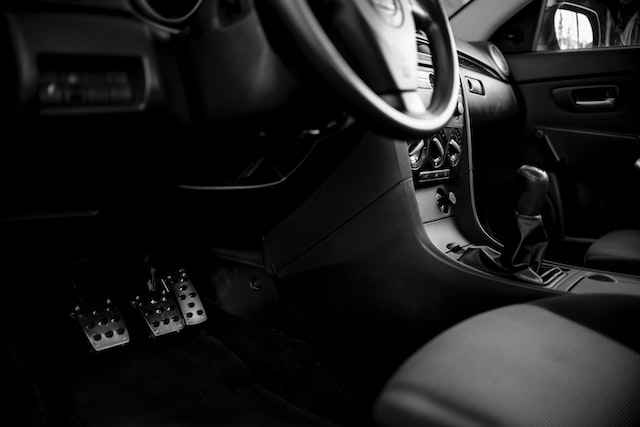
Cargroot is reader-supported. When you buy through links on our site, we may earn an affiliate commission.
You see it every day – a car going over the road with the right foot braking, and the same foot is used for the gas pedal. Why not use separate feet for both? Also, is the gas pedal always on the right? What happens if you press down on both together? This article will discuss these and other questions you may have regarding your gas pedal.
What Is the Difference Between the 2 Pedal and 3 Pedal Design?
There are two types of pedals in a car: the two-pedal and three-pedal design.
The two-pedal design consists of a brake pedal and a gas pedal. The brake pedal is used to stop the car from accelerating and is typically used to slow down the car. The accelerator pedal is used to increase or decrease the vehicle speed. This type of system is typically found on cars with automatic transmissions.
The three-pedal design has all three pedals: the clutch, accelerator, and brake pedals. The brake pedal is used to slow down or stop the vehicle, while the clutch and accelerator pedals are used to increase or decrease speed. This system is typically found on vehicles with manual transmissions.
Is the Gas Pedal Always Lower Than the Brake Pedal?
Well, there are a few reasons. First, stepping on a higher pedal is easier. This means that when driving in an emergency, for example, when there’s a car accident or an explosion ahead of you, and you need to stop quickly, it will be easier to react if your foot doesn’t have far to travel from its position on the gas pedal to reach down and press hard on the brake. The faster you can react, after all, the better chance there is that no one will get hurt!
What Happens When You Press the Clutch and Accelerator Together?
When you press the clutch and accelerator simultaneously, it’s called “riding the clutch.” When you ride the clutch, you’re basically revving your engine so that it can’t go into gear. This can cause damage to your car if you’re not careful.
When you ride the clutch, you’re also using up more gas than normal because your engine is constantly revving up and down. It’s like having a motorboat for an engine – it’s working hard to get going but not making much progress forward.
Does Europe Have the Gas Pedal on the Left?
No, Europe does not have the gas pedal on the left. The reason for this is that when cars were first invented, they were designed so that the driver controlled them with his right hand and pedals with his left foot.
This was partly because most people are right-handed but also because it would be hard to steer if you had your left foot on a pedal and vice versa.
In fact, most European countries follow the same practice as North America: putting the gas pedal on the right side of a vehicle’s steering wheel.
Which Foot Do People Use for Braking?
There is a lot of debate about which foot people use to brake when they drive. Some people argue that right-handed people tend to use their right foot for braking, while others argue that it’s more about which side you’re driving on.
Generally, most people use their right foot when braking in a manual transmission. In an automatic, you tend to use your left foot for the brake. This is primarily because your left foot is stuck to the clutch in a manual transmission.
Since most drivers need to press the clutch quite a few times, the left foot is kept free for it. Also, it is a known fact that you never press down the brake and accelerator together. This would defeat the purpose of accelerating. This allows you to toggle your right foot between the brake and accelerator.
What Happens if You Release the Clutch and Press Down on the Brake?
If you release the clutch and press down on the brake, your car will come to a screeching halt. That’s because when you release the clutch and press down on the brake, you’re essentially stopping your car in two different ways: by stalling the engine, which stops the wheels from spinning, and by applying pressure to the brakes, which slows down the wheels.
What Signs Should You Look Out for in a Failing Brake?
Brake failure can happen anytime, and it’s important to know what signs to look out for before it’s too late. If your brakes are failing, you may notice the following:
- A grinding noise when you depress the pedal.
- The pedal is getting softer or going to the floor without engaging the brakes.
- Your car pulls to one side when you brake.
- A burning smell is coming from your brake system.
Conclusion
So, where’s the gas pedal? Or, more importantly, which side of your car does it exist on? We hope this article clarified your doubts concerning your gas pedal position and other common questions you may have.



![[Solved] Car Shaking in Reverse – Why & How to Fix It?](https://cargroot.com/wp-content/uploads/2023/03/giorgio-trovato-gBF0CCP_Qy0-unsplash-100x70.jpg)


